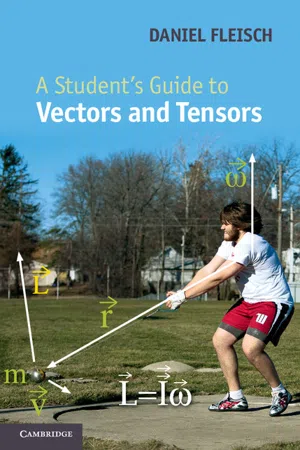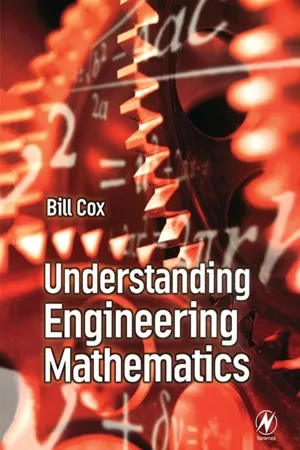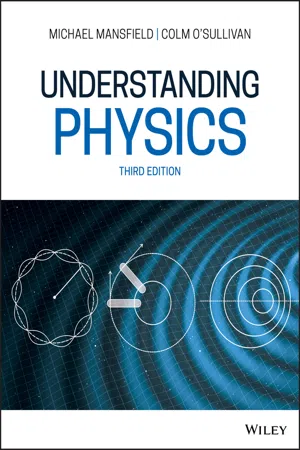Mathematics
Force as a Vector
In the context of mathematics, force as a vector refers to the representation of force as a quantity with both magnitude and direction. This concept is essential for understanding how forces act on objects in different directions and can be combined using vector addition. By treating force as a vector, mathematical models can accurately describe the complex interactions of forces in various physical systems.
Written by Perlego with AI-assistance
Related key terms
1 of 5
7 Key excerpts on "Force as a Vector"
- Paul Anthony Russell(Author)
- 2021(Publication Date)
- Reeds(Publisher)
As we work through the chapters, students will notice that ‘force’ is divided into the following two categories, which are: Students will notice that ‘contact’ forces are the forces exerted upon bodies when they physically touch each other and ‘non-contact’ forces are those that act on or between objects that are not in physical contact with each other. WEIGHT, with the symbol W, of a body describes the gravitational force acting on the mass of that body; gravitational acceleration (g) is 9.81 m/s 2 . weight (N) mass (kg) gravitational acceleration = × = W mg Contact forces Non-contact forces Compressive Electro-motive Tensile Gravitational Friction Magnetic Air resistance Normal Statics • 7 Vector and Scalar Quantities One of the most important reasons for marine engineers to have a full understanding and appreciation of the theoretical and scientific background of mechanical equipment is that they can exchange information and ideas with other engineers in the correct manner, leaving little chance for misunderstanding. When engineers and scientists wish to describe the physical qualities or properties of an object or substance, sometimes it will be enough to describe it by stating the magnitude. An example will be 5 litres of oil or half a kilogram of chemical powder; these are scalar quantities. Other entities will require both magnitude and direction for them to be fully described. For example, to fully describe a force, we need to specify both its magnitude and also its direction. When two properties are required to define an entity, it is called a vector quantity, and it can be represented by a vector diagram. A vector diagram is a line drawn to scale; in the case of a force, the length of the line represents the magnitude of the force, and the direction of the arrow drawn on the line represents the direction of action of the force. Other vectors are displacement, velocity, and acceleration.- eBook - PDF
- Daniel A. Fleisch(Author)
- 2011(Publication Date)
- Cambridge University Press(Publisher)
1 Vectors 1.1 Definitions (basic) There are many ways to define a vector. For starters, here’s the most basic: A vector is the mathematical representation of a physical entity that may be characterized by size (or “magnitude”) and direction. In keeping with this definition, speed (how fast an object is going) is not rep-resented by a vector, but velocity (how fast and in which direction an object is going) does qualify as a vector quantity. Another example of a vector quantity is force, which describes how strongly and in what direction something is being pushed or pulled. But temperature, which has magnitude but no direction, is not a vector quantity. The word “vector” comes from the Latin vehere meaning “to carry;” it was first used by eighteenth-century astronomers investigating the mechanism by which a planet is “carried” around the Sun. 1 In text, the vector nature of an object is often indicated by placing a small arrow over the variable representing the object (such as F ), or by using a bold font (such as F ), or by underlining (such as F or F ∼ ). When you begin hand-writing equations involving vectors, it’s very important that you get into the habit of denoting vectors using one of these techniques (or another one of your choosing). The important thing is not how you denote vectors, it’s that you don’t simply write them the same way you write non-vector quantities. A vector is most commonly depicted graphically as a directed line seg-ment or an arrow, as shown in Figure 1.1 (a). And as you’ll see later in this section, a vector may also be represented by an ordered set of N numbers, 1 The Oxford English Dictionary . 2nd ed. 1989. 1 2 Vectors (b) (a) Figure 1.1 Graphical depiction of a vector (a) and a vector field (b). where N is the number of dimensions in the space in which the vector resides. Of course, the true value of a vector comes from knowing what it represents. - eBook - ePub
- John Bird, Carl Ross(Authors)
- 2019(Publication Date)
- Routledge(Publisher)
In this chapter the fundamental quantities, scalars and vectors, which form the very basis of all branches of engineering, are introduced. A force is a vector quantity and, in this chapter, the resolution of forces is introduced. Resolving forces is very important in structures, where the principle is used to determine the strength of roof trusses, bridges, cranes, etc. Great lengths are gone to, to explain this very fundamental skill, where step-by-step methods are adopted to help the reader understand this very important procedure. The resolution of forces is also used in studying the motion of vehicles and other particles in dynamics and in the case of the navigation of ships, aircraft, etc., the vectors take the form of displacements, velocities and accelerations. This chapter gives a sound introduction to the manipulation and use of scalars and vectors, by both graphical and analytical methods. The importance of understanding the forces at a point is to appreciate the equilibrium of forces, whether they act on a structure or a machine or a mechanism.At the end of this chapter you should be able to:- distinguish between scalar and vector quantities
- define ‘centre of gravity’ of an object
- define ‘equilibrium’ of an object
- understand the terms ‘coplanar’ and ‘concurrent’
- determine the resultant of two coplanar forces using (a) the triangle of forces method (b) the parallelogram of forces method
- calculate the resultant of two coplanar forces using (a) the cosine and sine rules (b) resolution of forces
- determine the resultant of more than two coplanar forces using (a) the polygon of forces method (b) calculation by resolution of forces
- determine unknown forces when three or more coplanar forces are in equilibrium
Quantities used in engineering and science can be divided into two groups:5.1Scalar and vector quantities- (a) Scalar quantities have a size (or magnitude) only and need no other information to specify them. Thus, 10 centimetres, 50 seconds, 7 litres and 3 kilograms are all examples of scalar quantities.
- (b) Vector quantities have both a size or magnitude and a direction, called the line of action of the quantity. Thus, a velocity of 50 kilometres per hour due east, an acceleration of 9.81 metres per second squared vertically downwards and a force of 15 newtons at an angle of 30 degrees are all examples of vector quantities.
5.2Centre of gravity and equilibriumThe centre of gravity of an object is a point where the resultant gravitational force acting on the body may be taken to act. For objects of uniform thickness lying in a horizontal plane, the centre of gravity is vertically in line with the point of balance of the object. For a thin uniform rod the point of balance and hence the centre of gravity is halfway along the rod, as shown in Figure 5.1(a) - eBook - PDF
- Harold Josephs, Ronald Huston(Authors)
- 2002(Publication Date)
- CRC Press(Publisher)
163 6 Forces and Force Systems 6.1 Introduction Kinematics is a study of motion without regard to the causes of the motion. Alternatively, kinetics is a study of forces causing a motion. While knowledge of forces is based upon experience and intuition and upon studies in elementary physics and statics, it is helpful to review the fundamental concepts again, as they are essential in studying the dynamics of mechanical systems. Unlike unit vectors, position vectors, or velocity vectors, force vectors are generally associated with a point of application. Force vectors are thus bound vectors, whereas the other vectors are free vectors. To illustrate the importance of the point of application, consider the rod shown in Figure 6.1.1. Let a force F be applied perpendicular to the rod, first at end A and then at end B . The effect upon the rod of the different points of application is that in the first case (end A ) the rod will rotate clockwise, whereas in the second case (end B ) the rod will rotate counterclockwise. In this chapter, we review and discuss the analysis of forces and sets of forces (force systems) as they are applied with mechanical systems. We will consider various represen-tations of force systems, various kinds of force systems, and various methods of analysis. 6.2 Forces and Moments If we intuitively define a force as a push or pull applied in some direction at a point, the force may be represented as a bound vector . The force then has (1) a magnitude, (2) a line of action (defining its orientation), (3) a sense ( push or pull ), and (4) a point of application. Figure 6.2.1 depicts a force F acting at a point P with line of action L . A moment is defined as the rotational effect of a force about a point. This point is generally distinct from the points on the line of action of the force. - eBook - ePub
- Bill Cox(Author)
- 2001(Publication Date)
- Butterworth-Heinemann(Publisher)
11Vectors
Vectors are the mathematical tools needed when we deal with engineering systems in more than one dimension. Vector quantities such as force have both a magnitude and direction associated with them, and so are represented by mathematical symbols that, similarly, have a magnitude and direction. We can construct an algebra of such quantities by which they may be added, subtracted, multiplied (in two different ways) – but not divided. These rules of combination reflect the ways in which the corresponding physical quantities behave – for example vectors add in the same way that forces do, the scalar product represents ‘vector times vector = scalar’ in the same way that ‘velocity times velocity = energy’. By introducing a coordinate system, we can also represent vectors by arrays of ordinary numbers, in which form they are easier to combine and manipulate.Prerequisites It will be useful if you know something about•ratio and proportion (14 )•Cartesian coordinate systems (205 )•Pythagoras’ theorem (154 )•sines and cosines (175 )•cosine rule (197 )•simultaneous linear equations (48 )•function notation (90 )•differentiation (Chapter 8 )Objectives In this chapter you will find• definitions of scalars and vectors• representation of a vector• addition and subtraction of vectors• multiplication of a vector by a scalar• rectangular Cartesian coordinates in three dimensions• distance in Cartesian coordinates• direction cosines and ratios• angle between two lines•basis vectors (i , j , k - No longer available |Learn more
- (Author)
- 2014(Publication Date)
- Learning Press(Publisher)
In general, as long as all forces are due to the interaction of objects with mass, it is possible to define a system such that net momentum is never lost nor gained. ________________________ WORLD TECHNOLOGIES ________________________ Descriptions Free-body diagrams of an object on a flat surface and an inclined plane. Forces are resolved and added together to determine their magnitudes and the resultant. Since forces are perceived as pushes or pulls, this can provide an intuitive understanding for describing forces. As with other physical concepts (e.g. temperature), the intuitive understanding of forces is quantified using precise operational definitions that are consistent with direct observations and compared to a standard measurement scale. Through experimentation, it is determined that laboratory measurements of forces are fully consistent with the conceptual definition of force offered by Newtonian mechanics. Forces act in a particular direction and have sizes dependent upon how strong the push or pull is. Because of these characteristics, forces are classified as vector quantities. This means that forces follow a different set of mathematical rules than physical quantities that do not have direction (denoted scalar quantities). For example, when determining what happens when two forces act on the same object, it is necessary to know both the magnitude and the direction of both forces to calculate the result. If both of these pieces of information are not known for each force, the situation is ambiguous. For example, if you know that two people are pulling on the same rope with known magnitudes of force but you do not know which direction either person is pulling, it is impossible to determine what the acceleration of the rope will be. The two people could be pulling against each other as in tug of war or the two people could be pulling in the same direction. In this simple one-dimensional example, without knowing the direction of the - eBook - ePub
- Michael M. Mansfield, Colm O'Sullivan(Authors)
- 2020(Publication Date)
- Wiley(Publisher)
4 Motion in two and three dimensionsAIMS
- to show how, in two and three dimensions, physical quantities can be represented by mathematical entities called vectors
- to rewrite the laws of dynamics in vector form
- to study how the laws of dynamics may be applied to bodies which are constrained to move on specific paths in two and three dimensions
- to describe how the effects of friction may be included in the analysis of dynamical problems
- to study the motion of bodies which are moving on circular paths
4.1 Vector physical quantities
The material universe is a three‐dimensional world. In our investigation of the laws of motion in Chapter 3 , however, we considered only one‐dimensional motion, that is situations in which a body moves on a straight line and in which all forces applied to the body are directed along this line of motion. If a force is applied to a body in a direction other than the direction of motion the body will no longer continue to move along this line. In general, the body will travel on some path in three‐dimensional space, the detail of the trajectory depending on the magnitude and direction of the applied force at every instant. Equation (3.3) as it stands is not sufficiently general to deal with such situations, for example the motion of a pendulum bob (Figure 4.1 ) or the motion of a planet around the Sun (Figure 4.2 ). Newton's second law needs to be generalised from the simple one‐dimensional form discussed in Chapter 3 .A pendulum comprising a mass attached to the end of a string; the mass can move on a path such that the distance from the fixed end of the string remains constant.Figure 4.1A similar problem arises if two or more forces act on a body simultaneously, for example when a number of tugs are manoeuvring a large ship (Figure 4.3
Index pages curate the most relevant extracts from our library of academic textbooks. They’ve been created using an in-house natural language model (NLM), each adding context and meaning to key research topics.






